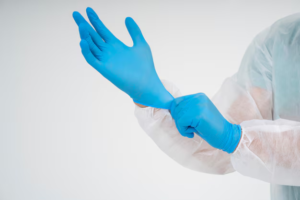

Medical examination gloves are one of the personal protective equipment used in healthcare facilities to minimize the transfer of germs and diseases between patients and health care workers. Medical examination gloves can be classified into many types and each type has its own characteristics and uses. Below are the various types of medical examination gloves and their pros and cons.
Common Types of Medical Examination Gloves
The three most common types of medical examination gloves are:
Latex Glove
Natural rubber latex, a protein obtained from rubber trees, manufactures latex gloves. These gloves have great flexibility, stretchability, and comfort during wear. They are also very strong and resistant to puncture. People use them in blood sampling, aseptic procedures, and examination procedures.
However, one of the major disadvantages of using latex gloves is that people with latex sensitivity may develop an allergic reaction. Latex sensitivity is becoming a significant problem in the healthcare setting.
Vinyl Gloves
Vinyl gloves are cheaper than latex gloves. They are manufactured from polyvinyl chloride (PVC) plastic, a synthetic material that does not contain latex proteins. Vinyl gloves are comfortable to wear and offer good protection against splashes and fluids. However, vinyl gloves are not as tough or puncture-proof as the latex gloves used in the healthcare industry. They are more likely to tear or rip easily and therefore. They should not be used for risky operations or those that require the use of sharp objects.
Vinyl gloves are cheap and have low allergic properties. Therefore, they are used in non-sterile operations like patient handling, food preparation, and cleaning.
Nitrile Gloves
Nitrile gloves are one of the many types of gloves used for many purposes, like latex gloves, but they do not cause allergic reactions. Synthetic nitrile rubber, a petroleum-derived material with high tensile strength, abrasion, and chemical resistance, makes them. Nitrile gloves are appropriate to use when there is contact with chemicals or other materials that are hazardous to the skin or the body, including chemotherapy drugs or cleaning products.
Nitrile gloves also offer good sensitivity and tactility and this makes it possible to handle small and intricate items. They are not as stretchable as latex gloves but nitrile gloves have good form fitting ability and are comfortable to wear.
Choosing the Right Medical Examination Gloves
The selection of the most appropriate medical examination gloves depends on several factors, including:
The nature of the procedure: Consider the amount of contact with blood, other body fluids, sharp objects, or chemicals involved in the procedure.
Allergy risk: If the person is likely to be sensitive to latex, vinyl or nitrile gloves should be worn.
Dexterity requirements: The flexibility of the latex gloves may be beneficial to operations that require delicate finger movements.
Durability needs: Choose the gloves with the right level of puncture resistance based on how often one is likely to encounter sharp objects.
Cost considerations: Vinyl is the cheapest type of gloves but you should also consider the fact that you may have to buy more gloves because of rips or tears.
Protect Your Staff and the Planet: Choose Sustainable Medical Gloves
Healthcare professionals must choose the right medical examination gloves. At A2 Sustainable Supplies, we offer a wide range of eco-conscious glove options made from recycled materials and with sustainable production practices. So, what are you waiting for? Don’t compromise on protection – make a sustainable choice for your healthcare facility today! Head over to A2 Sustainable Supplies to explore our selection!
About Us
A2 Sustainable Supplies is a minority-owned business focused on keeping life sustainable by providing goods and services to improve the living environment. Our list of medical and non-medical products is extensive and our ability to provide the products at a reasonable and competitive price is key.ttis, pulvinar dapibus leo.



